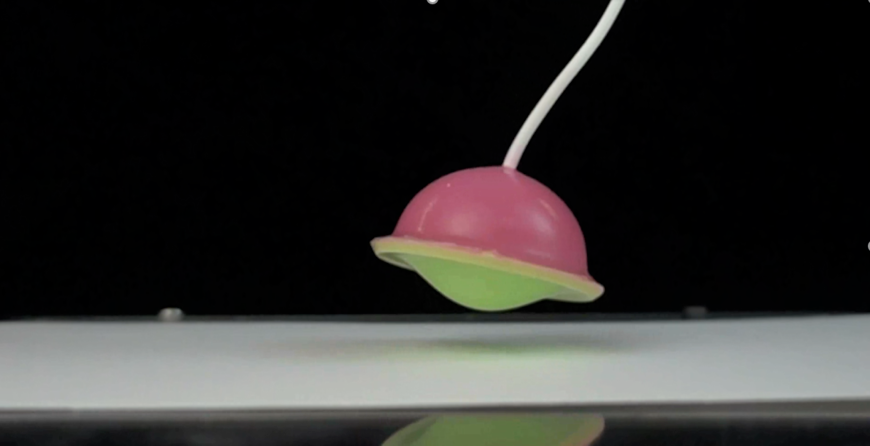May 21 2020
Buckling is the abrupt loss of structural stability and often a matter of engineering nightmares. Mechanical buckling leads to detrimental failure for a range of structural systems from soufflés to rockets.
 This hopping soft robot harnesses the same physics as a toy popper. When the structure of a popper buckles, the energy released sends the toy flying through the air. Now, researchers have harnessed that energy and used buckling to their advantage to build a fast-moving, inflatable soft actuator. Image Credit: David Melancon and Benjamin Gorissen/Harvard SEAS.
This hopping soft robot harnesses the same physics as a toy popper. When the structure of a popper buckles, the energy released sends the toy flying through the air. Now, researchers have harnessed that energy and used buckling to their advantage to build a fast-moving, inflatable soft actuator. Image Credit: David Melancon and Benjamin Gorissen/Harvard SEAS.
Buckling was the reason behind the Deepwater Horizon oil spill in 2010, and many other disasters.
However, people who have played with a toy popper can understand that buckling also liberates an enormous amount of energy. When a popper’s structure buckles, the energy emitted by the instability sends the toy flying in the air.
At present, scientists from the Harvard John A. Paulson School of Engineering and Applied Sciences (SEAS) and Harvard’s Wyss Institute for Biologically Inspired Engineering have tapped that energy and utilized buckling to their benefit to construct a fast-moving, inflatable soft actuator.
The study has been reported in the Science Robotics journal.
Soft robots have enormous potential for a wide spectrum of applications, ranging from minimally invasive surgical tools and exoskeletons to warehouse grippers and video game add-ons. But applications for today’s soft actuators are limited by their speed.
Benjamin Gorissen, Study Co-First Author and Postdoctoral Fellow, Harvard SEAS
Fluidic soft actuators power up and move relatively slow since they require a lot of fluid to work. Moreover, the flow, whether liquid or gas, is limited by valves and tubes in the device.
According to David Melancon, a graduate student at SEAS and co-first author of the study, “In this work, we showed that we can harness elastic instabilities to overcome this restriction, enabling us to decouple the slow input from the output and make a fast-jumping fluidic soft actuator.”
This actuator is a building block that could be integrated into a fully soft robotic system to give soft robots that can already crawl, walk and swim the ability to jump. By incorporating our jumper into these designs, these robots could navigate safely through uncharted landscapes
Katia Bertoldi, William and Ami Kuan Danoff Professor of Applied Mechanics, Harvard SEAS
Bertoldi is the senior author of the study and an Associate Faculty member of the Wyss Institute.
The team focused on the same kind of buckling that propels toy poppers, called shell buckling. They developed the actuators with two spherical caps—typically two poppers—embedded together like Russian nesting dolls and linked at the base.
When they are inflated, the pressure gets accumulated between the two caps. The thinner outer cap extends up and the thicker inner cap buckles and collapses, striking the ground and catapulting the device upward.
Although the device appears to be simple, gaining insights into the fundamental physics that acted was crucial to manipulate and maximize the performance of the robot. A majority of earlier studies into shell buckling analyzed how to prevent it. However, Gorissen, Melancon, and their colleagues intended to increase the instability.
As a coincidence, one of the pioneers of shell buckling research is just two floors down from Bertoldi’s group in Pierce Hall. Professor Emeritus John W. Hutchinson, who joined the Harvard faculty in 1964, has designed a few of the initial theories to define and measure the buckling shell structures.
According to Gorissen, “Our research shines a different perspective on some of [Hutchinson’s] theories and that enables us to apply them to a different research domain.”
It was nice to be able to get feedback from one of the pioneers in the field. He developed the theory to prevent failure and now we’re using it to trigger buckling.
David Melancon, Study Co-First Author and Graduate Student, Harvard SEAS
The researchers employed established theories and more advanced numerical simulation tools, thus characterizing and adjusting the pressure-volume relationship between the two shells to design a soft robot with the ability to rapidly liberate a particular amount of energy repeatedly.
The method can be applied to any size or shape. It could even be utilized in everything ranging from a small medical device to puncture a vein to huge exploratory robots to move over uneven terrain.
Nikolaos Vasios and Mehdi Torbati co-authored the study, which was partially supported by the National Science Foundation through grants DMR-1420570 and DMR-1922321.
Inflatable Soft Actuator
Experimental video of three actuator designs. By tuning the pressure-volume relationship between the two shells, the researchers were able to develop an actuator capable of releasing enough energy to jump, as seen in design C. Video Credit: David Melancon and Benjamin Gorissen/Harvard SEAS.
Journal Reference:
Gorissen, B., et al. (2020) Inflatable soft jumper inspired by shell snapping. Science Robotics. doi.org/10.1126/scirobotics.abb1967.